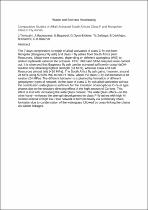 ResearchSpace
ResearchSpace
Comparative studies of Alkali activated South African Class F and Mongolian Class C fly ashes
JavaScript is disabled for your browser. Some features of this site may not work without it.
- ResearchSpace
- →
- Research Publications/Outputs
- →
- Journal Articles
- →
- View Item
| dc.contributor.author |
Temuujin, J

|
|
| dc.contributor.author |
Mapiravana, Joseph

|
|
| dc.contributor.author |
Bayarzul, U

|
|
| dc.contributor.author |
Oyun-Erdene, G

|
|
| dc.contributor.author |
Zolzaya, TS

|
|
| dc.contributor.author |
Darkhijav, B

|
|
| dc.contributor.author |
Dlamini, Mandla N

|
|
| dc.contributor.author |
Rüscher, CH

|
|
| dc.date.accessioned | 2018-08-22T09:38:03Z | |
| dc.date.available | 2018-08-22T09:38:03Z | |
| dc.date.issued | 2017-03 | |
| dc.identifier.citation | Temuujin, J, Mapiravana, J, Bayarzul, U. et.al. 2017. Comparative studies of Alkali activated South African Class F and Mongolian Class C fly ashes. Waste and Biomass Valorisation, 14pp. | en_US |
| dc.identifier.issn | 1877-2641 | |
| dc.identifier.uri | https://link.springer.com/article/10.1007/s12649-017-9881-5 | |
| dc.identifier.uri | http://hdl.handle.net/10204/10379 | |
| dc.description | Copyright: 2017 Springer. Due to copyright restrictions, the attached PDF file only contains the abstract of the full text item. For access to the full text item, kindly consult the publisher's website. | en_US |
| dc.description.abstract | The 7 days compressive strength of alkali activation of class C fly ash from Mongolia (Banganuur fly ash) and class F fly ashes from South Africa (Ash Resources, Ulala) were measured, depending on different waterglass (WG) to sodium hydroxide ratios in the activator. FTIR, XRD and SEM analyses were carried out. It is observed that Baganuur fly ash can be activated sufficiently using NaOH-solution only obtaining highest strength (33 MPa), whereas Ulala and Ash Resources almost fails (<10 MPa). The South Africa fly ash gains, however, around 28 MPa using 50:50% WG to NaOH ratios, where the class C-fly ash becomes a bit weaker (24 MPa). The different behavior is explained by formation of different geopolymer-types of network. In the case of class C fly ash alkali activation without the contribution waterglass is sufficient for the formation of amorphous C–S–H type phases due to the structure directing effect of the high amount of Ca-ions. This effect is lost with increasing the waterglass content. The waterglass effect—on the other hand—enforces the strength development for class F-fly ashes with high Al content instead of high Ca. Here network is formed mainly via preliminary chain formation due to condensation of the waterglass followed by cross-linking the chains via sialate linkages. | en_US |
| dc.language.iso | en | en_US |
| dc.publisher | Springer | en_US |
| dc.relation.ispartofseries | Worklist;20636 | |
| dc.subject | Alkaline solution | en_US |
| dc.subject | Class F-fly ash | en_US |
| dc.subject | Class C-fly ash | en_US |
| dc.subject | Geopolymers | en_US |
| dc.subject | Microstructure | en_US |
| dc.title | Comparative studies of Alkali activated South African Class F and Mongolian Class C fly ashes | en_US |
| dc.type | Article | en_US |
| dc.identifier.apacitation | Temuujin, J., Mapiravana, J., Bayarzul, U., Oyun-Erdene, G., Zolzaya, T., Darkhijav, B., ... Rüscher, C. (2017). Comparative studies of Alkali activated South African Class F and Mongolian Class C fly ashes. http://hdl.handle.net/10204/10379 | en_ZA |
| dc.identifier.chicagocitation | Temuujin, J, Joseph Mapiravana, U Bayarzul, G Oyun-Erdene, TS Zolzaya, B Darkhijav, Mandla N Dlamini, and CH Rüscher "Comparative studies of Alkali activated South African Class F and Mongolian Class C fly ashes." (2017) http://hdl.handle.net/10204/10379 | en_ZA |
| dc.identifier.vancouvercitation | Temuujin J, Mapiravana J, Bayarzul U, Oyun-Erdene G, Zolzaya T, Darkhijav B, et al. Comparative studies of Alkali activated South African Class F and Mongolian Class C fly ashes. 2017; http://hdl.handle.net/10204/10379. | en_ZA |
| dc.identifier.ris | TY - Article AU - Temuujin, J AU - Mapiravana, Joseph AU - Bayarzul, U AU - Oyun-Erdene, G AU - Zolzaya, TS AU - Darkhijav, B AU - Dlamini, Mandla N AU - Rüscher, CH AB - The 7 days compressive strength of alkali activation of class C fly ash from Mongolia (Banganuur fly ash) and class F fly ashes from South Africa (Ash Resources, Ulala) were measured, depending on different waterglass (WG) to sodium hydroxide ratios in the activator. FTIR, XRD and SEM analyses were carried out. It is observed that Baganuur fly ash can be activated sufficiently using NaOH-solution only obtaining highest strength (33 MPa), whereas Ulala and Ash Resources almost fails (<10 MPa). The South Africa fly ash gains, however, around 28 MPa using 50:50% WG to NaOH ratios, where the class C-fly ash becomes a bit weaker (24 MPa). The different behavior is explained by formation of different geopolymer-types of network. In the case of class C fly ash alkali activation without the contribution waterglass is sufficient for the formation of amorphous C–S–H type phases due to the structure directing effect of the high amount of Ca-ions. This effect is lost with increasing the waterglass content. The waterglass effect—on the other hand—enforces the strength development for class F-fly ashes with high Al content instead of high Ca. Here network is formed mainly via preliminary chain formation due to condensation of the waterglass followed by cross-linking the chains via sialate linkages. DA - 2017-03 DB - ResearchSpace DP - CSIR KW - Alkaline solution KW - Class F-fly ash KW - Class C-fly ash KW - Geopolymers KW - Microstructure LK - https://researchspace.csir.co.za PY - 2017 SM - 1877-2641 T1 - Comparative studies of Alkali activated South African Class F and Mongolian Class C fly ashes TI - Comparative studies of Alkali activated South African Class F and Mongolian Class C fly ashes UR - http://hdl.handle.net/10204/10379 ER - | en_ZA |





